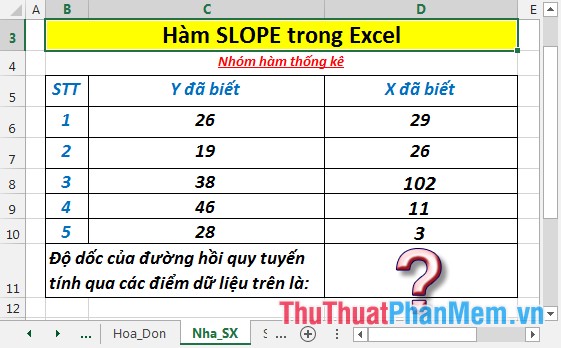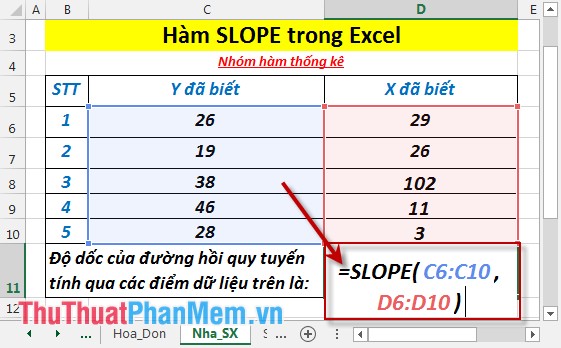SLOPE function - The function returns the slope of a linear regression line through data points in Excel
The following article introduces you to the SLOPE function - one of the functions in the group of statistical functions that is very popular in Excel.

Description: The function returns the slope of a linear regression line through data points. The slope is the vertical distance divided by the horizontal distance between any two points on that line, the rate of change along the regression line.
Syntax: SLOPE (known_y's, known_x's)
Inside:
- known_y's : An independent data point array or range.
- known_x's: The set of independent data points.
Attention:
- The value of the argument must be a number, name, array or reference containing numbers.
- If known_y's and known_x's are empty or have a different number of data points -> the function returns the # N / A error value .
- If the argument is a reference array containing text values or logic -> these values are ignored, but the value 0 is still counted.
- If argument values use invalid data types -> the function returns the #VALUE! Error value
- The slope equation for the regression line is:
[b = frac {{sum {left ({x - overline x} right) left ({y - overline y} right)}}} {{sum {{{left ({x - overline x} right)} ^ 2 }}}}]
Where x and y are the sample mean AVERAGE (known_x's) and AVERAGE (known_y's)
For example:
Calculate the slope of the linear regression line through data points in the following data table:

- In the cell to calculate enter the formula : = SLOPE (C6: C10, D6: D10)

- Press Enter -> slope of the linear regression line through the above data points is:

Above are instructions and some specific examples when using SLOPE function in Excel.
Good luck!
You should read it
- STEYX function - The function returns the standard error of the predicted value of y for each value of x in regression in Excel
- TREND - The function returns values in a linear trend in Excel
- AVEDEV function - The function returns the average absolute deviation of data points from their midpoint in Excel
- PEARSON function - The function returns the Pearson product moment correlation coefficient in Excel
- COVARIANCE.P function - The function returns the covariance of a set, the product of the average of degrees of instruction for each pair of data points in Excel
- DEVSQ function - The function returns the sum of squares of deviations of data points from the sample mean in Excel
- The syntax and function of each function in the group of statistical functions in Excel
- TRIMMEAN function - The function returns the average of the inner part of a dataset in Excel
May be interested
- How to use the NORMDIST function in Excel - Function that returns the distribution in Excel
 the normdist function returns a distribution with a specified mean and standard deviation. the normdist function has applications in statistics, including hypothesis testing.
the normdist function returns a distribution with a specified mean and standard deviation. the normdist function has applications in statistics, including hypothesis testing. - The syntax and function of each function in the group of statistical functions in Excel
 the statistical function is divided into 3 subgroups: the statistical group, the probability distribution function group and the linear regression and correlation function group.
the statistical function is divided into 3 subgroups: the statistical group, the probability distribution function group and the linear regression and correlation function group. - DEVSQ function in Excel The function returns the sum of squares of deviations between data points from their average
 devsq () is a function that returns the sum of squares of deviations between data points from their average.
devsq () is a function that returns the sum of squares of deviations between data points from their average. - SLN function - Returns the depreciation value of an asset using the straight-line method in Excel
 the following article details the syntax and usage of sln in excel. description: returns the depreciation of assets according to the straight-line method over a given period.
the following article details the syntax and usage of sln in excel. description: returns the depreciation of assets according to the straight-line method over a given period. - LINEST function - The function returns a line description array using the least square method in Excel
 linest function: the function returns the line description array using the least squares method. syntax: linest (known_ys, [known_xs], [const], [stats])
linest function: the function returns the line description array using the least squares method. syntax: linest (known_ys, [known_xs], [const], [stats]) - TRIMMEAN function - The function returns the average of the inner part of a dataset in Excel
 trimmean function: the function returns the average of the inside of the data set. the function calculates by removing which percentage of the value is in the first or last boundary of the data set. syntax: trimmean (array, percent)
trimmean function: the function returns the average of the inside of the data set. the function calculates by removing which percentage of the value is in the first or last boundary of the data set. syntax: trimmean (array, percent) - QUARTILE.EXC function - The function returns the quartile of a dataset without values 0 and 1 in Excel
 quartile.exc function: the function returns the quartile of the data set, with percentile values from 0 to 1 excluding 0 and 1. the support function is from excel 2010 onwards. syntax: quartile.exc (array, quart)
quartile.exc function: the function returns the quartile of the data set, with percentile values from 0 to 1 excluding 0 and 1. the support function is from excel 2010 onwards. syntax: quartile.exc (array, quart) - F.DIST.RT function - The function returns the right probability distribution F for 2 data sets in Excel
 f.dist.rt function: the function returns the right probability distribution f for 2 data sets. support functions from the excel 2010 version. syntax: f.dist (x, deg_freedom1, deg_freedom2)
f.dist.rt function: the function returns the right probability distribution f for 2 data sets. support functions from the excel 2010 version. syntax: f.dist (x, deg_freedom1, deg_freedom2) - FTEST function - The function returns the result of an F-Test in Excel
 the following article details how to use ftest - the function returns the result of an f-test. in statistical probability, the determination of the correctness and the deviation between two data samples is a regular and extremely important job.
the following article details how to use ftest - the function returns the result of an f-test. in statistical probability, the determination of the correctness and the deviation between two data samples is a regular and extremely important job. - HARMEAN function - The function returns the harmonic average of a data set in Excel
 harmean function: the function returns the harmonic mean of a dataset, the harmonic mean is the reciprocal of the arithmetic mean of the reciprocals. syntax: harmean (number1, [number2], ...)
harmean function: the function returns the harmonic mean of a dataset, the harmonic mean is the reciprocal of the arithmetic mean of the reciprocals. syntax: harmean (number1, [number2], ...)










 SMALL function - The function returns the kth smallest value in a dataset in Excel
SMALL function - The function returns the kth smallest value in a dataset in Excel STANDARDIZE function - The function returns the normalized value from a specific distribution in Excel
STANDARDIZE function - The function returns the normalized value from a specific distribution in Excel STDEV.P function - The function returns the standard deviation based on the whole in Excel
STDEV.P function - The function returns the standard deviation based on the whole in Excel STDEV.S function - The function returns the standard deviation based on a sample in Excel
STDEV.S function - The function returns the standard deviation based on a sample in Excel GAMMA.INV function - The function returns the inverse of the gamma distribution in Excel
GAMMA.INV function - The function returns the inverse of the gamma distribution in Excel GAMMALN function - The function returns the natural logarithm of the gamma function, Γ (x) in Excel
GAMMALN function - The function returns the natural logarithm of the gamma function, Γ (x) in Excel